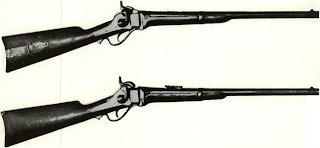Three Sharps long guns were made in Hartford for
All Civil War Sharps arms were percussion cap, using a combustible cartridge of glazed linen. In the front
In the author’s collection is a Sharps 30-inch New
the merits of the Sharps guns. Though Colt in his controversial way had once urged his agent in the west
General Ben Butler upon taking command in Baltimore immediately purchased 200 New Model
For a lawyer, Ben Butler drew up a cloudy contract.
stock mortise surrounding the block spring, underneath the barrel. This can build up and if a trace of
The excitement of Bull Run caused many changes
Sharps Rifle Manufacturing Company
Hartford, July 9,
It is our understanding that each arm is accompanied by
Respectfully &c
J. C. Palmer, President.
General J. W. Ripley
By March 8, , starting with 300 carbines delivered September 13, , Palmer had turned in 8,800 accepted carbines. Deliveries were so much according to schedule and quality so high, that Ripley named
Palmer did not have to come to Washington to defend himself against Holt and Owen in their relentless
We are not certain if he took all of Bean’s 500 Sharps
Palmer sold directly to the United States 100 sword
Bean ultimately delivered 100 carbines at $30 on
of General Nathaniel Banks’ “U. S. Police” force
The 6,000 carbines Palmer was making were inspected in an unusual fashion, for contract arms. They
This should refer to a new Model carbine without detailed inspectors’ marks under the finishing on
February 15, : send “soon as made” 343 Sharps carbines
June 26, : “all the Sharps carbines you can manufacture
September 9, : “all the Sharps carbines you can manufacture for the three months next ensuing after the expiration
December 19, : “all you can deliver for three months”
All Civil War Sharps arms were percussion cap, using a combustible cartridge of glazed linen. In the front
In the author’s collection is a Sharps 30-inch New
the merits of the Sharps guns. Though Colt in his controversial way had once urged his agent in the west
General Ben Butler upon taking command in Baltimore immediately purchased 200 New Model
For a lawyer, Ben Butler drew up a cloudy contract.
stock mortise surrounding the block spring, underneath the barrel. This can build up and if a trace of
The excitement of Bull Run caused many changes
Sharps Rifle Manufacturing Company
Hartford, July 9,
It is our understanding that each arm is accompanied by
Respectfully &c
J. C. Palmer, President.
General J. W. Ripley
By March 8, , starting with 300 carbines delivered September 13, , Palmer had turned in 8,800 accepted carbines. Deliveries were so much according to schedule and quality so high, that Ripley named
Palmer did not have to come to Washington to defend himself against Holt and Owen in their relentless
We are not certain if he took all of Bean’s 500 Sharps
Palmer sold directly to the United States 100 sword
Bean ultimately delivered 100 carbines at $30 on
of General Nathaniel Banks’ “U. S. Police” force
The 6,000 carbines Palmer was making were inspected in an unusual fashion, for contract arms. They
This should refer to a new Model carbine without detailed inspectors’ marks under the finishing on
February 15, : send “soon as made” 343 Sharps carbines
June 26, : “all the Sharps carbines you can manufacture
September 9, : “all the Sharps carbines you can manufacture for the three months next ensuing after the expiration
December 19, : “all you can deliver for three months”




Comments
Post a Comment